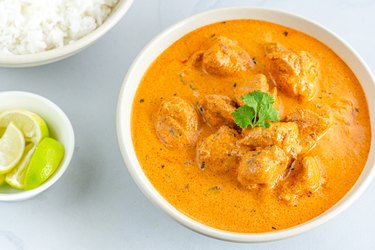
Perk up a plain chicken dinner by making it into a curry, and have boiled rice on the side to sop it up. When it comes to computing those chicken curry calories, a lot depends on the type of curry you prepared, the ingredients used, and your serving size.
Tip
The number of chicken curry calories depends on the ingredients used to make it and the amount you serve yourself. A 1-cup serving of an average chicken curry dish with a cup of boiled white rice contains between 300 and 400 calories.
Video of the Day
Types of Chicken Curry
Chicken curry isn't one set recipe. Curries come from India, Thailand and even the Caribbean. Each has a slightly different set of ingredients that alter the calorie count.
Video of the Day
For example, curries of India differ in their calorie counts. Just 5 ounces of the well-known dish chicken tikka masala, a curry made with milk or cream, tomatoes, chicken meat, onions and spices, carries 230 calories, 19 grams of protein, 14 grams of fat and 5 grams of carbohydrates per serving. A 5-ounce portion is equal to about 1 cup.
The mildest Indian chicken curry, known as chicken korma, contains onions, coconut milk, whipping cream, chicken and spices. It has 190 calories per 5-ounce serving, with 20 grams of protein, 8 grams of fat 7 grams of carbohydrates.
If you've got a taste for spicy, you might choose India's spicy curry dish, known as chicken vindaloo. It's a very hot dish made with peppers, coconut milk, and onions. You also get 190 calories in 5 ounces, 22 grams of protein, 8 grams of fat and 7 grams of carbohydrates.
Thai coconut curry has 210 calories per 5 ounces with 21 grams of protein, 9 grams of fat and 11 grams of carbohydrates. The recipe contains chicken meat, soy sauce, coconut milk, peppers and other Asian spices and flavorings.
The type of chicken curry you order at a restaurant or make at home isn't always specified. A basic chicken curry is usually made with chicken, curry sauce and seasonings. Assume this chicken curry's calorie count to be 220 per 5 ounces, with 19 grams of protein, 13 grams of fat and 7 grams of carbohydrates.
As a side note, if you're making chicken curry at home, add a few extra vegetables. Slivered carrots, sliced zucchini, peas and broccoli all make delicious additions and won't dramatically change the calorie count. However, these extra vegetables will help you boost your nutrient intake.
Calories in Rice
White rice contains 150 calories per half-cup serving. It adds 3 grams of protein and 33 grams of carbohydrates, with no fat or fiber.
Opt for whole-grain brown rice instead, to accompany your chicken curry, and take in 170 calories per half-cup. You'll also get 4 grams of protein and 36 grams of carbs along with 1.5 grams of fat. One of the greatest benefits of choosing brown rice, however, is the added 2 grams of fiber it contains. Brown rice isn't as refined as the white variety.
Women should aim for 25 grams of fiber daily, and men for 38 grams, according to the Academy of Nutrition and Dietetics. A high-fiber diet can help you feel full, promoting a healthy weight. Adequate fiber intake also keeps your cholesterol levels in check, and keeps your system regular, preventing constipation.
Read More: 10 Myths About Grains — Totally Busted
Serving sizes matter when you're calculating calorie counts. Think of a half-cup serving of rice fitting into a woman's palm, or filling up about two-thirds of a man's palm. If you eat larger servings, the calorie count obviously goes up.
- USDA Nutrient Database: "Chicken Curry"
- USDA Nutrient Database: "Thai Coconut Curry Chicken"
- USDA Nutrient Database: "Chicken Tikka Masala"
- USDA Nutrient Database:"Chicken Korma"
- USDA Nutrient Database: "Chicken Vindaloo"
- USDA Nutrient Database: "Cooked White Rice"
- USDA Nutrient Database: "Cooked Brown Rice"
- Academy of Nutrition and Dietetics: "Easy Ways to Boost Fiber in Your Diet"
- Penn State Extension: "Size Up Your Portions"